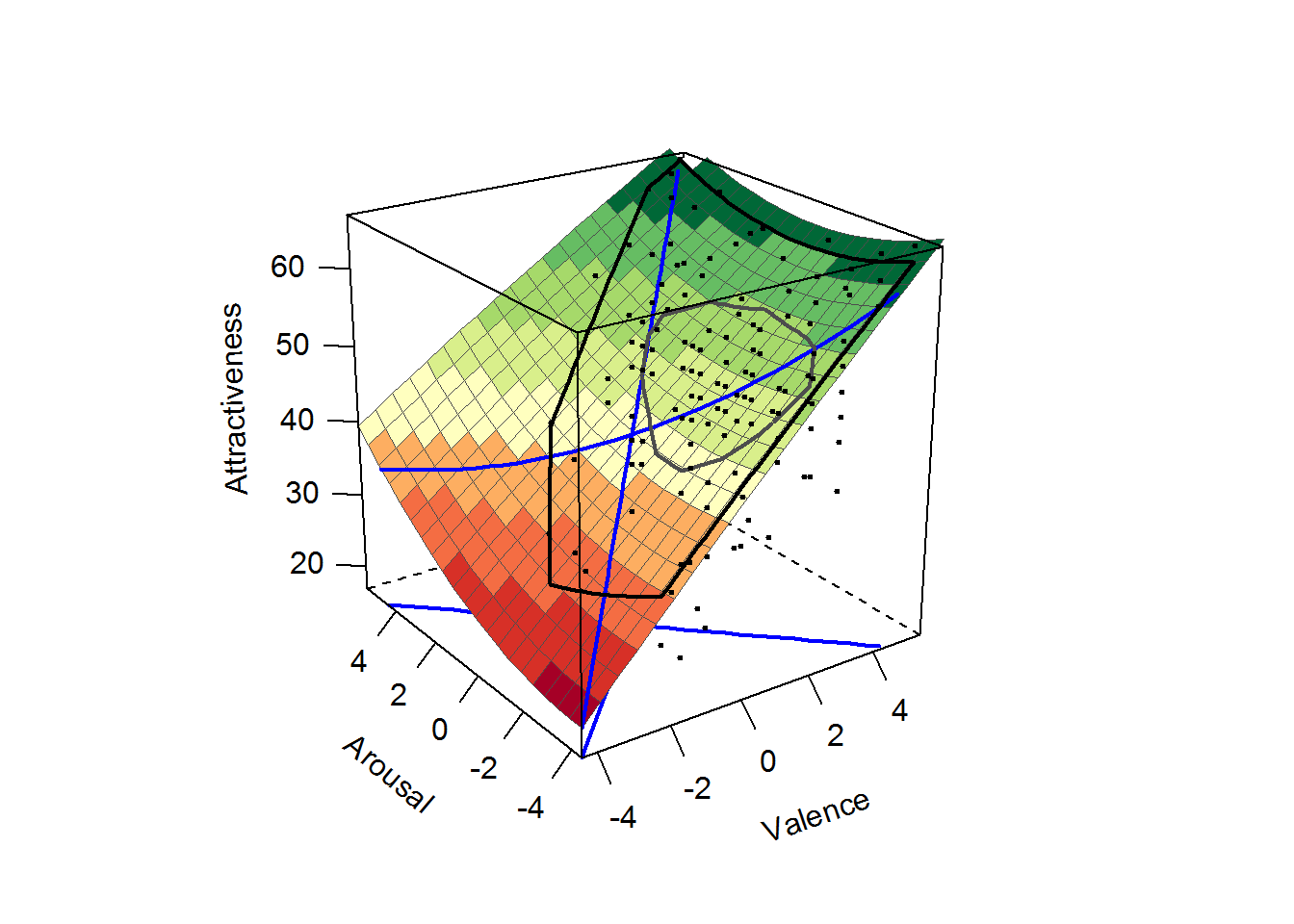The Theory
Response Suface Analysis (RSA) is a method from the wider field of Response Surface Methodologies (RSM).
Requirements
Commensurable Scales
Commensurability explained as briefly as possible is that two scales are measured in the same units. In the world of Likert-scales this mostly means they are measured on the same number of points.
Centered on a Common Point
There is a number of ways this can be done. The most straight forward is probably to subtract scale midpoint from each participants score. This leaves participants with scores below the theoretical midpoint with negative values and everyone else with positive values.
Participants can indicate high and low values on all scales
This is more of a scale design than a analysis issue. Here it is important to consider if negatively worded items should need to be included in the scale or if the lowest level of a positively worded item is the lowest score a participant could indicate.
No Multicolliniearity
In contrast to the previous requirement this one is actually testable. The easiest way of doing this would be to run a regression with all predictors and examine the Variance Inflation Factors (VIF). An example can be seen below where I predict attractiveness of a landscape from ratings of valence and arousal. valence and arousal are centered around the scale mid-point of 5. VIF values below 5 are generally considered acceptabily low to conclude that there is no mulitcolliniearity.
car::vif(lm(attr ~ val_cent * aro_cent + val_cent2 + aro_cent2, data = data_long))## val_cent aro_cent val_cent2 aro_cent2 ## 4.027766 5.436807 4.003578 1.931477 ## val_cent:aro_cent ## 4.594957In our current example we might have a slight multicolliniearity issue, but we are going to accept it for the purpose of the example.
High Power
RSA How-To
library("RSA")## Loading required package: lavaan## This is lavaan 0.6-3## lavaan is BETA software! Please report any bugs.## Loading required package: latticersa_sqd <- RSA(t_attr ~ val_cent * aro_cent, data = data_long, model = "full")## [1] "Computing polynomial model (full) ..."summary(rsa_sqd)## RSA output (package version 0.9.13)
## ===========================================## Warning in sqrt(b3 * b5): NaNs produced
## Warning in sqrt(b3 * b5): NaNs produced
## Warning in sqrt(b3 * b5): NaNs produced
## Warning in sqrt(b3 * b5): NaNs produced
## Warning in sqrt(b3 * b5): NaNs produced## Are there discrepancies in the predictors (with respect to numerical congruence)?
## ----------------------------
## Congruence
## aro_cent < val_cent Congruence aro_cent > val_cent
## 75.6 21.7 2.8
##
## Is the full polynomial model significant?
## ----------------------------
## Test on model significance: R^2 = 0.428, p <.001
##
##
## Number of observations: n = 180
## ----------------------------
##
##
## Regression coefficients for model <full>
## ----------------------------
## label est se ci.lower ci.upper beta
## t_attr~1 b0 42.582 1.120 40.387 44.776 4.270
## t_attr~val_cent b1 4.001 0.667 2.694 5.308 0.584
## t_attr~aro_cent b2 0.914 0.540 -0.144 1.972 0.200
## t_attr~val_cent2 b3 -0.027 0.142 -0.306 0.251 -0.016
## t_attr~val_cent_aro_cent b4 -0.180 0.156 -0.485 0.126 -0.120
## t_attr~aro_cent2 b5 0.190 0.106 -0.017 0.397 0.115
## pvalue sig
## t_attr~1 p <.001 ***
## t_attr~val_cent p <.001 ***
## t_attr~aro_cent p = .091 †
## t_attr~val_cent2 p = .848
## t_attr~val_cent_aro_cent p = .250
## t_attr~aro_cent2 p = .072 †
##
##
##
## Surface tests (a1 to a5) for model <full>
## ----------------------------
## label est se ci.lower ci.upper pvalue sig
## 1 a1 4.915 0.787 3.373 6.457 p <.001 ***
## 2 a2 -0.017 0.179 -0.367 0.333 p = .924
## 3 a3 3.088 0.924 1.277 4.898 p <.001 ***
## 4 a4 0.342 0.240 -0.129 0.813 p = .154
## 5 a5 -0.217 0.206 -0.621 0.186 p = .291
##
## a1: Linear additive effect on line of congruence? YES
## a2: Is there curvature on the line of congruence? NO
## a3: Is the ridge shifted away from the LOC? YES
## a4: Is there a general effect of incongruence? NO
##
##
## Location of stationary point for model <full>
## ----------------------------
## val_cent = 31.761; aro_cent = 12.61; predicted t_attr = 111.888
##
##
## Principal axes for model <full>
## ----------------------------
## label est se ci.lower ci.upper pvalue sig
## Intercept of 1. PA p10 100.890 189.332 -270.194 471.975 p = .594
## Slope of 1. PA p11 -2.779 2.382 -7.449 1.890 p = .243
## Intercept of 2. PA p20 1.183 2.439 -3.598 5.964 p = .628
## Slope of 2. PA p21 0.360 0.308 -0.245 0.964 p = .243
## --> Lateral shift of first PA from LOC at point (0; 0): C1 = 56.696
## --> Lateral shift of second PA from LOC at point (0; 0): C2 = -0.87# PLOT THE ESTIMATED MODEL
plot(rsa_sqd, legend=F, param=F,
axes=c("LOC", "LOIC","PA1"),
project=c("LOC", "LOIC","PA1"),
xlab="Valence", ylab="Arousal", zlab="Attractiveness"
)
